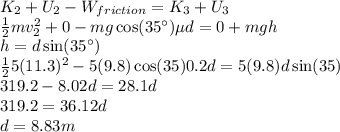An object of mass 5.0 kilograms initially travelling at12.0m/s
horizentally enters a region wh...

Physics, 09.01.2020 04:31 montgomerykarloxc24x
An object of mass 5.0 kilograms initially travelling at12.0m/s
horizentally enters a region where there is a coefficientof kinetic
friction of 0.27
a) use the concepts of work and energy to determine thespeed
of the mass after it has traveled 3 meters.
b) the mass now continues its motion by sliding up a 35degree
incline. how far up the incline will it travel before comingto rest?
the coefficient of friction between the mass and theincline is
0.20.
c) now solve the same problems in a and b usingnewton's laws-
force mass, and acceleration.

Answers: 1


Other questions on the subject: Physics




Physics, 22.06.2019 13:10, kelonmazon2492
The bar of prob. 5/82 is repeated here. the ends of the 0.4-m bar remain in contact with their re- spective support surfaces. end b has a velocity of 0.5 m/s and an acceleration of 0.3 m/s2 in the di- rections shown. determine the angular accelera- tion of the bar and the acceleration of end a.
Answers: 3
You know the right answer?
Questions in other subjects:

Computers and Technology, 27.04.2020 03:06




Mathematics, 27.04.2020 03:06


World Languages, 27.04.2020 03:06



Mathematics, 27.04.2020 03:06









